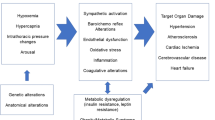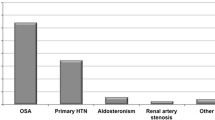Abstract
Obstructive sleep apnea-hypopnea (OSAH) is regarded as an increasingly common cause of sustained hypertension. The vast majority of mechanistic studies linking these entities have focused on the role of sympathoactivation. This review therefore addresses this purported mechanism by highlighting studies conducted in the past 5 years that speak to OSAH-related changes in sympathoregulation, independent of obesity, as well as the intervening players and pathways that may be relevant to such changes. Finally, studies with a focus on changes in sympathoregulation induced by continuous positive airway pressure (CPAP) therapy are discussed. Taken together, these findings strengthen the claim that the sympathoadrenal pressor system is essential for the development of the hypertensive state in individuals with OSAH.
Similar content being viewed by others
References and Recommended Reading
Basner RC: Continuous positive airway pressure for obstructive sleep apnea. N Engl J Med 2007, 356:1751–1758.
Strohl KP, Redline S: Recognition of obstructive sleep apnea. Am J Respir Crit Care Med 1996, 154:279–289.
Young T, Palta M, Dempsey J, et al.: The occurrence of sleep-disordered breathing among middle-aged adults. N Engl J Med 1993, 328:1230–1235.
Ryan CM, Bradley TD: Pathogenesis of obstructive sleep apnea. J Appl Physiol 2005, 99:2440–2450.
Nieto FJ, Young TB, Lind BK, et al.: Association of sleep-disordered breathing, sleep apnea, and hypertension in a large community-based study. Sleep Heart Health Study. JAMA 2000, 283:1829–1836.
Peppard PE, Young T, Palta M, Skatrud J: Prospective study of the association between sleep-disordered breathing and hypertension. N Engl J Med 2000, 342:1378–1384.
Bazzano LA, Khan Z, Reynolds K, He J: Effect of nocturnal nasal continuous positive airway pressure on blood pressure in obstructive sleep apnea. Hypertension 2007, 50:417–423.
Rahmouni K, Correia ML, Haynes WG, Mark AL: Obesity-associated hypertension: new insights into mechanisms. Hypertension 2005, 45:9–14.
Narkiewicz K, van de Borne PJ, Cooley RL, et al.: Sympathetic activity in obese subjects with and without obstructive sleep apnea. Circulation 1998, 98:772–776.
Grassi G, Facchini A, Trevano FQ, et al.: Obstructive sleep apnea-dependent and -independent adrenergic activation in obesity. Hypertension 2005, 46:321–325.
Leuenberger UA, Brubaker D, Quraishi S, et al.: Effects of intermittent hypoxia on sympathetic activity and blood pressure in humans. Auton Neurosci 2005, 121:87–93.
Cutler MJ, Swift NM, Keller DM, et al.: Hypoxia-mediated prolonged elevation of sympathetic nerve activity after periods of intermittent hypoxic apnea. J Appl Physiol 2004, 96:754–761.
Tamisier R, Anand A, Nieto LM, et al.: Arterial pressure and muscle sympathetic nerve activity are increased after two hours of sustained but not cyclic hypoxia in healthy humans. J Appl Physiol 2005, 98:343–349.
Gilmartin GS, Tamisier R, Curley M, Weiss JW: Ventilatory, hemodynamic, sympathetic nervous system, and vascular reactivity changes following recurrent nocturnal sustained hypoxia in humans. Am J Physiol Heart Circ Physiol 2008, 295:H778–H785.
Weiss JW, Liu MD, Huang J: Physiological basis for a causal relationship of obstructive sleep apnoea to hypertension. Exp Physiol 2007, 92:21–26.
Narkiewicz K, van de Borne PJ, Montano N, et al.: Contribution of tonic chemoreflex activation to sympathetic activity and blood pressure in patients with obstructive sleep apnea. Circulation 1998, 97:943–945.
Cutler MJ, Swift NM, Keller DM, et al.: Periods of intermittent hypoxic apnea can alter chemoreflex control of sympathetic nerve activity in humans. Am J Physiol Heart Circ Physiol 2004, 287:H2054–H2060.
Tamisier R, Nieto L, Anand A, et al.: Sustained muscle sympathetic activity after hypercapnic but not hypocapnic hypoxia in normal humans. Respir Physiol Neurobiol 2004, 141:145–155.
Cooper VL, Pearson SB, Bowker CM, et al.: Interaction of chemoreceptor and baroreceptor reflexes by hypoxia and hypercapnia—a mechanism for promoting hypertension in obstructive sleep apnoea. J Physiol 2005, 568:677–687.
Cooper VL, Bowker CM, Pearson SB, et al.: Effects of simulated obstructive sleep apnoea on the human carotid baroreceptor-vascular resistance reflex. J Physiol 2004, 557:1055–1065.
Cooper VL, Elliott MW, Pearson SB, et al.: Daytime variability of baroreflex function in patients with obstructive sleep apnoea: implications for hypertension. Exp Physiol 2007, 92:391–398.
Cooper VL, Elliott MW, Pearson SB, et al.: Daytime variability in carotid baroreflex function in healthy human subjects. Clin Auton Res 2007, 17:26–32.
Lai CJ, Yang CC, Hsu YY, et al.: Enhanced sympathetic outflow and decreased baroreflex sensitivity are associated with intermittent hypoxia-induced systemic hypertension in conscious rats. J Appl Physiol 2006, 100:1974–1982.
Dematteis M, Julien C, Guillermet C, et al.: Intermittent hypoxia induces early functional cardiovascular remodeling in mice. Am J Respir Crit Care Med 2008, 177:227–235.
Fletcher EC: Invited review: physiological consequences of intermittent hypoxia: systemic blood pressure. J Appl Physiol 2001, 90:1600–1605.
Dujic Z, Ivancev V, Heusser K, et al.: Central chemoreflex sensitivity and sympathetic neural outflow in elite breath-hold divers. J Appl Physiol 2008, 104:205–211.
Fu Q, Townsend NE, Shiller SM, et al.: Intermittent hypobaric hypoxia exposure does not cause sustained alterations in autonomic control of blood pressure in young athletes. Am J Physiol Regul Integr Comp Physiol 2007, 292:R1977–R1984.
Heitmann J, Ehlenz K, Penzel T, et al.: Sympathetic activity is reduced by nCPAP in hypertensive obstructive sleep apnoea patients. Eur Respir J 2004, 23:255–262.
Narkiewicz K, Kato M, Phillips BG, et al.: Nocturnal continuous positive airway pressure decreases daytime sympathetic traffic in obstructive sleep apnea. Circulation 1999, 100:2332–2335.
Mills PJ, Kennedy BP, Loredo JS, et al.: Effects of nasal continuous positive airway pressure and oxygen supplementation on norepinephrine kinetics and cardiovascular responses in obstructive sleep apnea. J Appl Physiol 2006, 100:343–348.
Phillips CL, Yang Q, Williams A, et al.: The effect of short-term withdrawal from continuous positive airway pressure therapy on sympathetic activity and markers of vascular inflammation in subjects with obstructive sleep apnoea. J Sleep Res 2007, 16:217–225.
Imadojemu VA, Mawji Z, Kunselman A, et al.: Sympathetic chemoreflex responses in obstructive sleep apnea and effects of continuous positive airway pressure therapy. Chest 2007, 131:1406–1413.
Bonsignore MR, Parati G, Insalaco G, et al.: Baroreflex control of heart rate during sleep in severe obstructive sleep apnoea: effects of acute CPAP. Eur Respir J 2006, 27:128–135.
Logan AG, Tkacova R, Perlikowski SM, et al.: Refractory hypertension and sleep apnoea: effect of CPAP on blood pressure and baroreflex. Eur Respir J 2003, 21:241–247.
Noda A, Nakata S, Koike Y, et al.: Continuous positive airway pressure improves daytime baroreflex sensitivity and nitric oxide production in patients with moderate to severe obstructive sleep apnea syndrome. Hypertens Res 2007, 30:669–676.
Kohler M, Pepperell JC, Casadei B, et al.: CPAP and measures of cardiovascular risk in males with OSAS. Eur Respir J 2008, 32:1488–1496.
Author information
Authors and Affiliations
Corresponding author
Rights and permissions
About this article
Cite this article
Friedman, O., Logan, A.G. Sympathoadrenal mechanisms in the pathogenesis of sleep apnea-related hypertension. Current Science Inc 11, 212–216 (2009). https://doi.org/10.1007/s11906-009-0037-2
Published:
Issue Date:
DOI: https://doi.org/10.1007/s11906-009-0037-2




